Please Take Note: This is a review of the final game, but it might change slightly based on the success of the Kickstarter campaign. The game is being reviewed on the components and the rules provided with the understanding that “what you see is not what you might get” when the game is published. If you like what you read and want to learn more, we encourage you to visit the publisher’s website or visit the Kickstarter campaign. Now that we have all that disclaimer junk out of the way, on with the review.
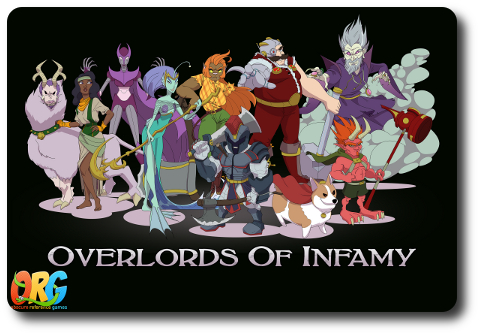
The Basics:
- For ages 8 and up (publisher suggests 13+)
- For 2 to 4 players
- Approximately 60 minutes to complete
Geek Skills:
- Active Listening & Communication
- Counting & Math
- Logical & Critical Decision Making
- Reading
- Strategy & Tactics
- Hand/Resource Management
- Worker Placement & Area Control
Learning Curve:
- Child – Moderate
- Adult – Easy
Theme & Narrative:
- It’s not easy being the bad guy…
Endorsements:
- Gamer Geek approved!
- Parent Geek approved!
- Child Geek mixed!
Overview
Being an Overlord is not as glamorous as the tabloids would have you believe. Yes, the parties are “off the hook” and having vast armies that do your bidding makes chores simple, but that’s not the whole picture. Being an Overlord means you are always in the spotlight and expected to hatch new diabolical plots. It is, in short, work. And don’t even get me started on the competition…
Overlords of Infamy, designed by David Zuckman and to be published by Obscure Reference Games, will reportedly be comprised of 1 game board, 4 Turn reference sheets, 4 Resource reference cards, 55 Map tiles, 84 Resource tokens (12 each of Water, Food, Wood, Fauna, Scrap, SparkTech, and Conjure Ore), 6 Relic cards, 24 Lackey meeples (6 per player in 4 different colors), 4 Infamy markers (1 per player in 4 different colors), 1 World Tension marker, 8 Overlord Playmats, 8 Lair tiles, 4 Sabotage tokens, 1 Adventuring Hero meeple, 1 six-sided die, 35 Knavery Plot cards, 30 Villainy Plot cards, 25 Domination Plot cards, and 60 World Event cards. As this is a review of a prepbulished game, I cannot comment on the component quality. The prototype we received represented a good portion of the completed game, including the artwork that portrait the would be evil overlords and the happy little kingdom that had no idea they were about to be attacked.
Dawn Over the Kingdom
To set up the game, first place the game board in the middle of the playing area.
Second, have each player select an Overlord Playmat and 1 matching Lair tile or randomly distribute them as pairs. These are placed in front of the owning player. Any Overlord Playmats and Lair tiles not selected are returned to the game box. Give each player a set of single colored Lackey meeples and an Infamy marker of the same color. Any Lackey meeples and Infamy tokens not selected are returned to the game box.
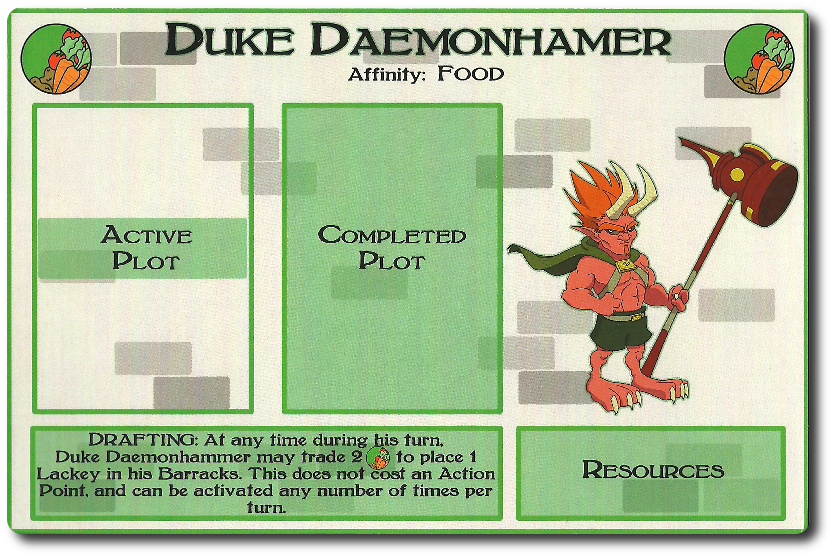
Each Overlord has a unique affinity and ability that gives the player a slight advantage, but not enough to overpower
Third, each player now places their Lair tile on the corners of the game board using the hexagon grid as a guide. Three Lackey meeples are immediately placed on the “Barracks” section of the Lair. The other 3 remain off the game board for now. Each player also places their Infamy marker on the “1” space found on the Infamy tracker. One player should also place the Tension marker on the “1” space found on the Tension track.
Fourth, shuffle the Knavery Plot cards and deal 2 to each player, face-down. Each player reviews their cards and keeps one, placing it face-down on the “Active Plot” space found on their Overlord Playmat. The unselected Knavery Plot card is handed back to the dealer who places them at the bottom of the Knavery Plot card deck. The Knavery deck is then placed face-down on the game board in its designated spot. This is the Knavery Plot draw deck for the duration of the game.
Fifth, shuffle the Villainy and Domination Plot cards separately and place them face-down next to the Knavery Plot draw deck. Then shuffle the World Event cards and place them face-down on the game board, as well.
Sixth, shuffle the Map tiles and organize them into roughly equal piles. Each pile is placed face-down on the game board on designated spots. The Adventuring Hero meeple is now places in the middle of the hexagon map. This area of the map is referred to as the “Adventuring Hero’s HQ”.
Seventh, place the Resources, Relic cards, unused tokens, and the six-sided die off to one side and within easy reach of the game players. Playing aids can now be passed out, as well.
That’s it for game set up. Determine who will be the first player and begin.
The Kingdom of Good
At the center of the game board lies the Kingdom of Good, an altogether horrid destination where everyone gets along and no one swears. Its champion is the Adventuring Hero who will venture forth and cause problems for the Overlords. Not in a specific kind of way, but in a very annoying general kind of way that is one part predictable and one part unavoidable.

What a disgusting place…
The land of the kingdom has been organized into hexagons, making it easy to see which neighbor is happily bordering which farm and how best to maintain roads. Very sensible really and the Overlords have adopted this method themselves, by organizing their Lair into 3 adjoining hexagons. Here, the Overlords will plot, plan, and go about dreaming of crushing the Kingdom of Good. Their small piece of land contains “Barracks” for their Lackeys and represents a dream in the making.
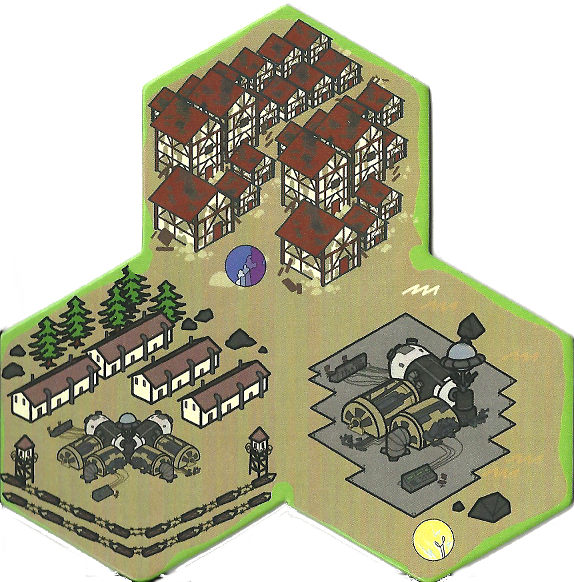
The land around the Overlord’s little slice of heaven is ripe for the taking. Tilled farmland, deep-green forests, and majestic hills can be torn down, mined, and chopped to produce the raw materials necessary to raise an army and build an empire. Map tiles provide Resources that are used to create and complete Plots.
- Lackeys are the hands, ears, eyes, and whatever body part the Overlord requires. They are loyal and dumb, exactly the way you want them to be. They can be found in villages by the hundreds.
- Conjure Ore are magical stones that occur naturally, but few know of their true potential.
- Scrap is all that remains of that which has been tossed aside. Trash to many, but a very viable resource to those who know how to use it.
- Fauna are both wild and domesticated, used for labor and to fill the belly.
- Food is abundant in this green and lush land. Enough to feed an Overlords army.
- Water is required to make steam war machines, various nasty chemicals, and water the rose bushes.
- Wood is the preferred material by carpenters or anyone who likes to burn things.
- SparkTech (yes, it’s a thing) contains limitless power that can be used for just about anything you can imagine.
There are also Map tiles that do not provide any Resources, but can be used to stop the Adventuring Hero from poking around.
Old School Villainy
Overlords of Infamy is played in rounds and turns. The number of rounds played is determined by the number of players in the game (anywhere from 6 to 10 rounds of game play). A player’s turn is summarized here.
Phase 1: Hail to the Hero
The first phase focuses on the Adventuring Hero meeple, which acts as a semi-neutral party in the game that causes trouble for the players. This phase is skipped during the player’s first turn, giving everyone a small bit of time to organize their armies and get their dastardly plans in order.
On the player’s second and subsequent turns, they check the Tension track. If the Tension marker is on the “3”, “6”, or “9” space on the previous player’s turn, the player rolls the six-sided die and moves the Adventuring Hero meeple that many spaces on the map. The Adventuring Hero meeple must move at least 1 space and cannot return to the Adventuring Hero’s HQ in most cases (there are always exceptions).
Based on where the Adventuring Hero meeple lands, the following actions take place.
- If the Adventuring Hero meeple ends its movement on a Map tile, none of the players can use that Map tile or send any of their Lackey meeples.
- If the Adventuring Hero meeple ends its movement on a Map tile with a Lackey meeple, 1 Resource from the Map tile and the Adventuring Hero meeple are placed on the Adventuring Hero’s HQ. All Lackey meeples on that space are returned to their owner.
- If the Adventuring Hero meeple ends its movement on a player’s Lair tile, half of the player’s basic Resources and the Adventuring Hero meeple are placed on the Adventuring Hero’s HQ. Any Relic cards the player has are returned to the Relic card pile.
- If the Adventuring Hero meeple ends its movement on a Map tile that doesn’t contain any Lackey meeples, the current player can choose to “liberate” the tile by removing it, placing it at the bottom of any Map tile stack, and returning the Adventuring Hero meeple to its HQ. The only time this action is not available is if the Map tile is in a contested area.
Phase 2: Dastardly Deeds (a.k.a. “Actions”)
Before the player goes any further, they should first stop to determine if there are any effects that trigger at the start of the player’s turn. Technically, phase 1 belongs to the hero of this game, not the Overlords. If they do, they resolve them now.
Each player starts the game with a Knavery Plot card. This card describes what the player needs to collect and present in order to successfully complete it. A player’s turn should be focused on completing these cards and more advanced Plot cards so as to earn Misery Points. The more misery the player can cause, the better Overlord they will become.
The player now has 3 actions that they must take. What 3 actions they decide to take is up to them. Actions fall into 2 categories: general and special. The general actions can always be taken by the players. The special actions tend to only be taken to counter other actions. Each action is summarized here and can be taken as many times as the player likes and is allowed by the rules.
Harvest Resource
Most Map tiles provide a Resource (the player’s Lair tile provides a Resource, as well). There are 7 types of Resources to collect and the only way to get them is to place a Lackey meeple on the Map tile. However, the Map tile must not be occupied by another opponent’s Lackey or the player’s Lackey meeple. Only Lackey’s that are currently in the player’s “Barracks” space on their Lair tile can be used.
Placing a Lackey meeple on a Map tile that provides a Resource automatically allows the player to collect that same Resource and add it to their Overlord Playmat. Each time this action is used, the Tension marker is moved to the next highest space, thematically representing the growing concern from the land’s populace over the Overlords’ activities.
Recruit Lackey
This action is identical to the Harvest Resource action, but instead of harvesting a Resource, the player gains an additional Lackey meeple. This is done by placing a Lackey meeple from the “Barracks” and placing it on a “Village” Map tile. One of the player’s unused Lackey meeples are placed in the “Barracks” and can be immediately used. Each time this action is used, the Tension marker is moved to the next highest space, thematically representing the growing horror that the Overlords are recruiting innocent unemployed meeples.
Recall Lackey
Sending a Lackey meeple from the “Barracks” to harvest resources and draft new members into the Overlord’s ranks removes them from play temporarily. For 1 action, a player can return their Lackey meeple to the “Barracks” where they can be used again this same turn. The only restriction is that Lackey meeples used to harvest and recruit this turn cannot be recalled during the same turn. Additionally, Lackey meeples that are no longer in the player’s Zone of Control cannot be returned, either.
Optionally, a player can recall all their Lackey meeples (regardless of the total number outside of the “Barracks”) as a single and only action for their turn.
Exploit the Land
The land that surrounds the Overlord Lair is green, fertile, and peaceful. This will not do. This action allows the player to draw 2 Map tiles and then select 1 to place to the game board. The Map tile must be placed in the player’s “Zone of Influence”, which is defined as adjacent tiles that are solely controlled by the player. The unselected Map tile is placed at the bottom of a Map tile stack. If all the available area in a player’s Zone of Influence has been exploited, they cannot take this action.
Complete a Plot
This action can be done for free, but cannot be done at all until the player has collected all the requirements noted on their current Plot card. Additionally, this action can only be done during this portion of the player’s turn. If the player has the correct number of Resources and the correct number of Lackey meeples in their “Barracks” that their current Plot card requires, they cackle evilly and announce that they have succeeded where others have failed. The Resources spent are returned to the general pool and Lackey’s required are taken off the “Barracks”.
The Plot card is then placed face-up on their Overlord Playmat. If the Plot card has an aftermath, it‘s read out loud at this time. All players must play to the aftermath if the text suggests that the effects of the Plot card influence the game for everyone.
Finally, the player’s Infamy level increases by 1 and the Tension level increases by 1, 2, or 3 (depending on the Plot card type completed). The player must now select 2 new Plot cards and keep 1 to use. Which Plot card type the player can use depends on their current Infamy level.
- Infamy Level 1 – 2: Knavery Plot cards only
- Infamy Level 3 – 4: Knavery and Villainy Plot cards only
- Infamy Level 5: Knavery, Villainy, and Domination Plot cards
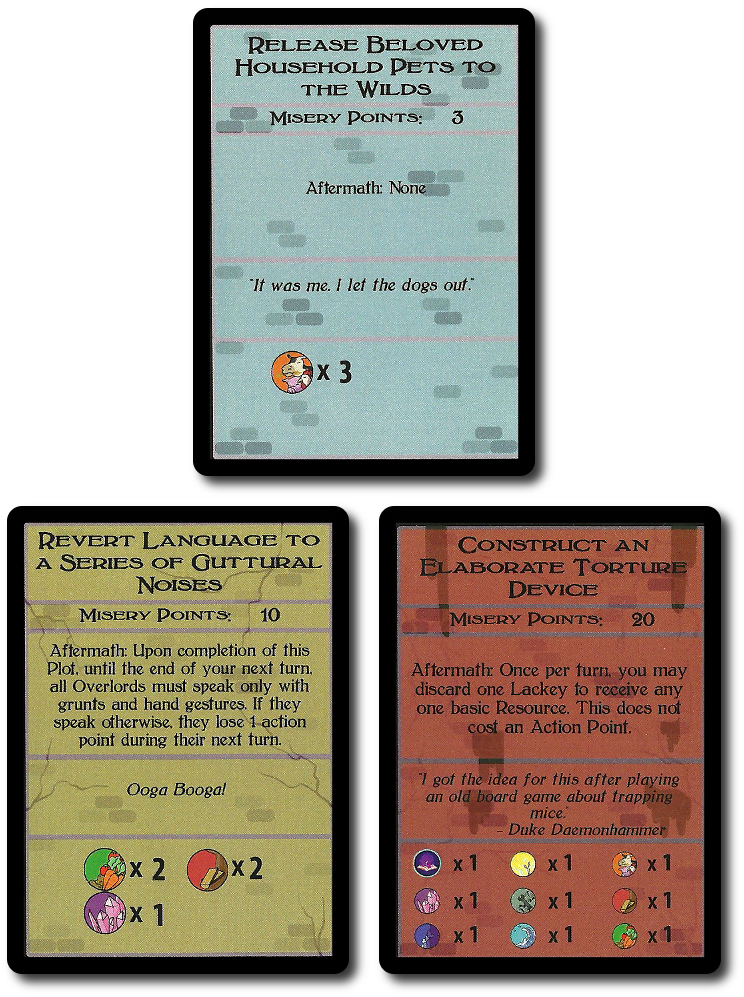
It would be incorrect to suggest that any Plot card type is more difficult than the others, as the requirements are always about collecting resources. However, what a player needs to take into consideration is the time it will take to complete the Plot card.
Start from Scratch
This is another action that can be taken for free. As previously stated, some Plot cards require a lot of resources. If a player feels that they are pursuing a plot card they cannot complete in a reasonable amount of time, they can ditch it. Their current Plot card is returned to the bottom of the draw pile and 2 additional Plot cards are drawn. Not before the player’s Infamy score is reduced by -1, however. The player’s new Infamy level might influence what Plot cards the player can take.
Special Actions
There are a handful of special actions the players might take during the game, but these are normally not used until later in the game. They are briefly summarized here.
- Steal a Relic Card (2 actions): If the player is able to Exploit the Land next to the central “Kingdom of Good”, they can draw 1 Relic card. Only 1 Relic card can be claimed by a player at a time.
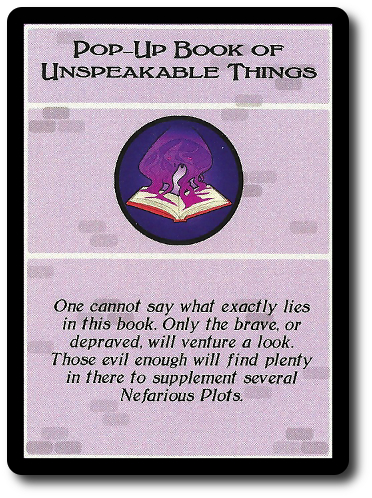
- Raid the Hero’s Treasure (2 actions): The Adventuring Hero meeple steals Resources during the game, but what was stolen can be stolen back. If the player is able to Exploit the Land next to the Central “Kingdom of Good”, and the Adventuring Hero meeple is not in its HQ, the player can discard 1 Lackey meeple and take all the Resources in the HQ as their own. Such a deed increases the Tension track by +3).
- Activate Plot Reward (cost indicated on Plot card): A completed Plot card with an award can be used once per game.
- Sweep for Infiltrators (1 action): If an opponent has placed their Lackey meeples in a player’s Zone of Influence, they can send them packing back to their master.
Phase 3: Espionage
Robbing the rich and bullying the poor is not the only thing an Overlord does during the day. They also spend a lot of their time thinking about their rivals. Espionage actions can only be taken after the player has completed their other actions. This last action is free and very optional. Additionally, espionage is only possible if two opposing players have Map tiles adjacent to each other. This area is contested. The “Kingdom of Good” automatically connects any other players together if they are connected to the kingdom.
What act the player can attempt is based on their current Infamy level. Some actions require the use of Resources and Lackeys.
- Level 1: Glean Intel: Look at the opponent’s current face-down Plot card.
- Level 2: Infiltrate: Place 1 Lackey meeple on an unoccupied Map tile belonging to the opponent.
- Level 3: Plunder Resources: Roll the dice to determine how many Resources can be taken from an opponent’s supply.
- Level 4: Sabotage: Place a Sabotage token on the opponent’s Plot card. When the Plot card is revealed and completed, they must first remove the Sabotage token effects or the Plot fails.
- Level 5: Assassinate: “Kill off” an opposing player’s Lackey that occupies a Map tile (a more violent version of Infiltrate).
Phase 4: End of Turn
The player’s turn is now over. Any effects that lasted for the duration of their turn now end. The next player goes in turn order sequence.
World Events and the End of the Game
World Events are drawn when the Tension maker hits “10”. A World Event card is drawn, read out loud, and influences the rest of the game until another World Event is drawn to replace it. The Tension marker then returns to its lowest value on the track. The tension will always rise and rise quickly if the players aggressively seek to plunder the land, rule its people, and fight against each other. Which is the point of the game.
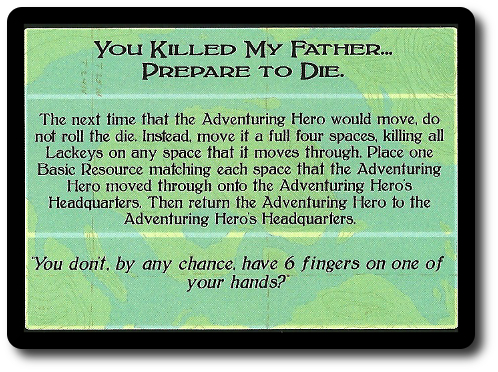
The game ends when a specific number of World Event cards have been drawn. This means the players have, to some degree, control over the length of their game’s length. The number of World Event cards necessary to end the game is based on the number of players, but this number can be increased or decreased for a longer or shorter game. After the required number of World Event cards are drawn and the last one resolve, the round is completed. Points are then calculated to determine the winner.
The players’ collect their completed Plot cards and add the Misery Point values together. In addition, they add the following points to their Plot cards:
- 1 point for every Lackey on the map and in the player’s “Barracks”
- 1/2 point for every Resource
- 2 points for a Relic card
The player with the most points is the winner and the Über Overlord.
To learn more about Overlords of Infamy, visit the publisher’s website or visit the Kickstarter campaign.
Final Word
The Child Geeks couldn’t decide if they liked the game. Their initial impressions were all very positive, but as the game progressed, they started to lose interest. According to one Child Geek, “The game’s OK, but it just feels like it’s moving too slowly.” Another Child Geek said, “I’ve played games like this before where you have to keep gathering resources, but I don’t feel like I’m doing anything an evil overlord would be doing.” What it came down to for the Child Geeks was the game’s theme. If the Child Geeks understood the thematic elements were there to help glue the game play to the overall arching narrative, they had no problem. Those who could not or did not just saw the game as a long exercise in gathering resources. The end result was a mixed review from the Child Geeks. The older and more experienced crowd game Overlords of Infamy their approval, while the others did not.
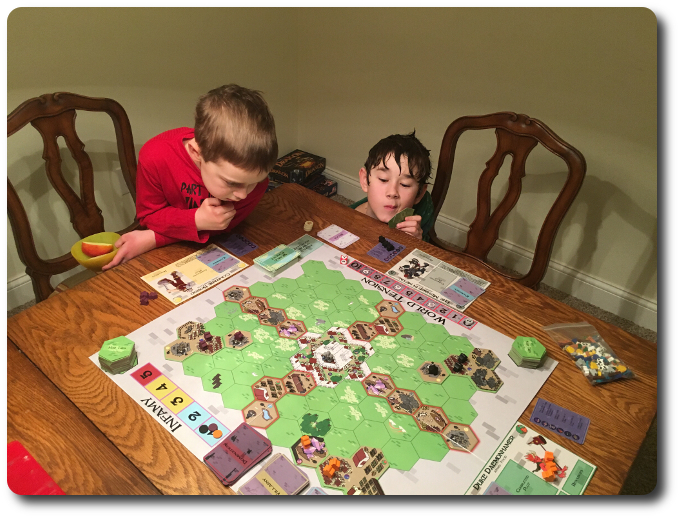
Games always started out strong, but tended to get weaker as the rounds passed by…
The Parent Geeks enjoyed the game’s challenge and the game’s theme. They also very much enjoyed the game’s humor. According to one Parent Geek, “Some of these cards are hilarious!” But another Parent Geek said, “I like humor in my games, but I wish they could have made it even a bit more outrageous. Make the player feel like the Overlord they are acting as cannot and should never be taken seriously. That would be funnier.” Game play was considered by all to be fairly smooth and only a little bit confusing at times. All the Parent Geeks liked that the game could be shortened or increased by adjusting the number of World Event cards. The end result was a full approval from the Parent Geeks.
The Gamer Geeks appreciated the game’s humor and game play. Especially the challenge of taking on more time-consuming Plot cards for a larger return. According to one Gamer Geek, “The designer appears to have balanced the game very well, giving players lots of options. I particularly like all the choices I have during my turn and assigning my Lackeys to do my bidding.” Another Gamer Geek said, “I like the game’s theme, find the Overlords a bit too silly at times, and am eager to play it again so I can try another tactic.” The only aspect of the game that was not enjoyed by the Gamer Geeks was the single road to victory. Completing Plots was the only method used to win with the extra points nothing more than a footnote. Regardless, all the Gamer Geeks approved it.
Overlords of Infamy is one of those resource gathering games that give a player a lot to do, but it all comes right back to the same focused objective. The different Plot cards make these objectives unique for each player and give them something to think about. For example, completing Knavery Plot cards is fairly quick and doesn’t do much to impact the game, but provides little in the way of Misery Points. On the other far side, Domination Plot card give a lot of points, heavily impact the world, and feel like they take forever to complete. A player is never able to collect more resources per turn then they have Lackeys. This takes time and time is not on the player’s side.
Which got me wondering why the Plot cards were connected to the Infamy levels of the player’s Overlords. By the time I had enough Infamy to collect the Domination Plot cards, I didn’t want to do it because I knew I didn’t have the time. Seems to me providing the player the ability to collect Plots of their choosing right from the start would be a better way to go. Luckily, players can swap out their Plot cards if they feel they bit off more than they can chew, but at the cost of reducing their Infamy. Which isn’t that big of a deal if you aren’t using it.
Overall I’m pleased with the game, the Adventuring Hero was fun to move around, interacting with the other players via Espionage actions felt very satisfying, and there is a genuine need to deeply consider how to use Resources and Lackeys. The key to this game is efficiency and efficiency is only possible if a player has a strategy. It’s very easy to waste time in the game, but you wouldn’t know you were doing it. Each action taken is rewarding with immediate results. The savvy player will know if the results are working towards their Plot or not.
If you enjoy games where area control and resource management go hand in hand, where begin bad feels pretty good, and the most annoying thing in the world is that damnable hero with flowing blonde hair and chiseled jaw line, then do try your hand at becoming an overlord. A bad guy you might be, but the game is good clean fun.
This is a paid for review of the game’s final prototype. Although our time and focus was financially compensated, our words are our own. We’d need at least 10 million dollars before we started saying what other people wanted. Such is the statuesque and legendary integrity of Father Geek which cannot be bought except by those who own their own private islands and small countries.



